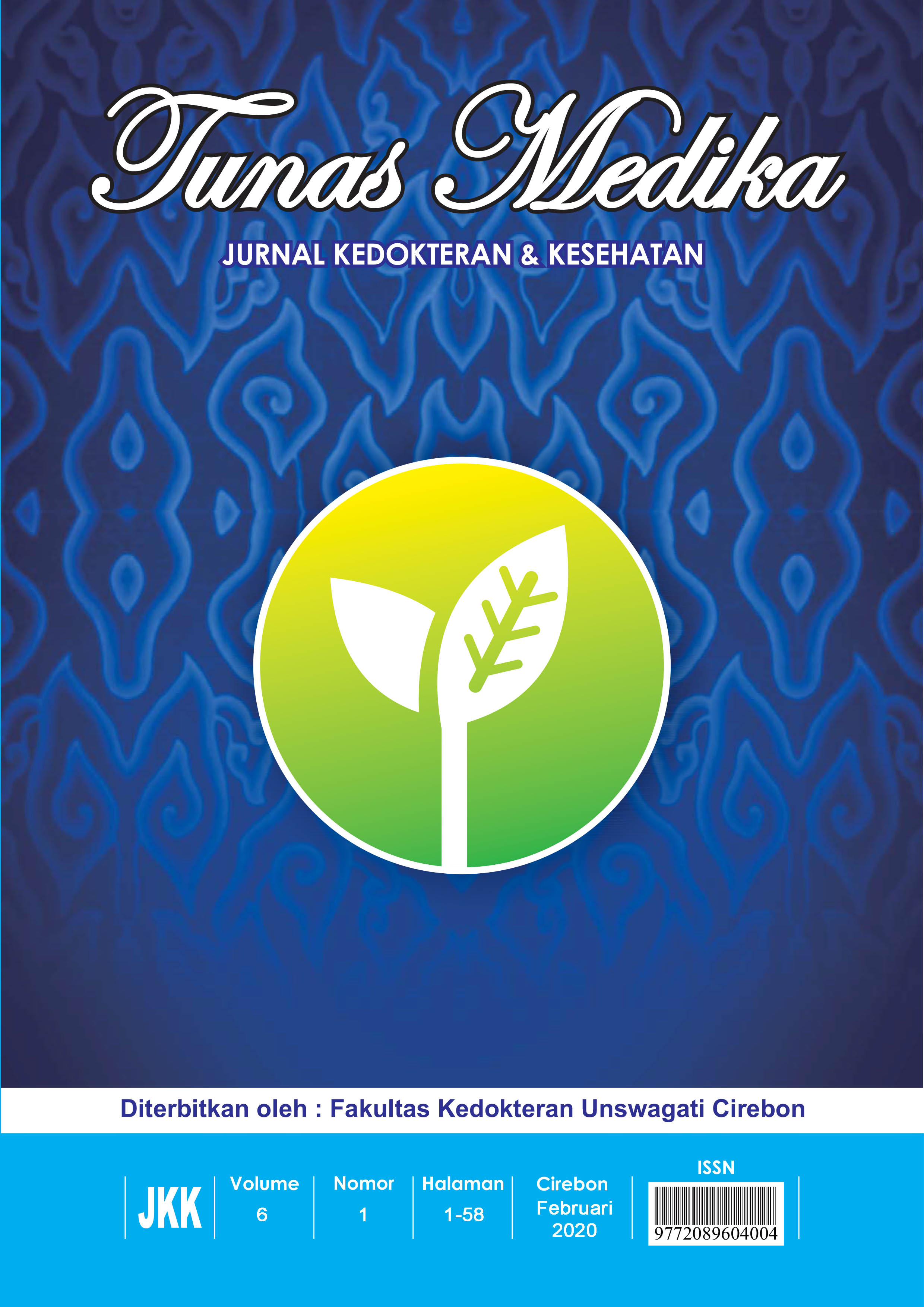Aktivitas Antibakteri Ekstrak Aseton Teratai Putih (Nymphaeae alba) terhadap Bakteri Streptococcus pyogenes
DOI:
https://doi.org/10.33603/tumed.v6i1.3263Abstract
ABSTRAK
Latar Belakang: Streptococcus pyogenes merupakan salah satu patogen yang banyak menginfeksi manusia.S. pyogenes dapat menyebabkan penyakit invasive seperti infeksi tulang, necrotizing fasciitis, radang otot, meningitis dan endokarditis. Salah satu tumbuhan yang memiliki potensi sebagai antibakteri adalah teratai putih (Nymphaeaealba). Beberapa penelitian telah dilakukan untuk mengidentifikasi senyawa yang terkandung di dalam N. alba dengan identifikasi fitokimia, senyawa-senyawa itu antara lain: tannin, asam galat, alkaloid, sterol, flavonoid, tannin terglikosida dan polifenol. Flavonoid merupakan senyawa metabolit sekunder yang memiliki aktivitas antibakteri yang sangat baik. Tujuan dari penelitian ini adalah mengkaji aktivitas antibakteri ekstrak aseton batang, daun dan rimpang teratai putih (N. alba) terhadap bakteri Streptococcus pyogenes. Metode: Simplisia daun, batang dan rimpang teratai putih dimaserasi dengan aseton selama 3 x 24 jam. Selanjutnya dilakukan uji antibakteri dengan metode Disc diffusion Kirby-Bauer dengan menggunakan amoksilin sebagai kontrol positif dan DMSO 20% sebagai kontrol negatif. Hasil: Uji antibakteri menunjukan bahwa ekstrak aseton daun, batang dan rimpang teratai putih memiliki aktivitas antibakteri yang dikategorikan kuat.Dengan zona hambat 27 mm (daun), 18 mm (batang) dan 26 mm (rimpang), diduga bahwa kandungan flavonoid yang terdapat di dalam terata putih yang bertanggung jawab atas aktivitas antibakteri ini. Simpulan: Teratai putih memiliki potensi yang cukup besar sebagai agen antibakteri.
Kata kunci : Teratai putih, antibakteri, S. pyogenes
Â
Â
ABSTRACT
Introduction: Streptococcus pyogenes is one of the many pathogens that infects humans. S. pyogenes can cause invasive diseases such as bone infection, necrotizing fasciitis, muscle inflammation, meningitis and endocarditis. One plant that has antibacterial potential is white water lily (Nymphaeae alba). Several studies have been conducted to identify compounds contained in N. alba with identification of phytochemicals, these compounds include: tannin, gallic acid, alkaloids, sterols, flavonoids, glycoside tannins and polyphenols. Flavonoids are secondary metabolites that have excellent antibacterial activity. The purpose of this study was to study the antibacterial activity of acetone stem, leaf extract and white lotus rhizome (N. alba) against Streptococcus pyogenes. Methods: Simplicia of leaves, stems and white lotus rhizomes macerated with acetone for 3 x 24 hours. Antibacterial tests were then carried out using the Kirby-Bauer diffusion Disc method using amoxicillin as a positive control and 20% DMSO as a negative control. Results: Antibacterial test results showed that acetone leaves, stem and white lotus rhizome extract had strong antibacterial activity. With a 27 mm inhibition zone (leaf), 18 mm (stem) and 26 mm (rhizome). It is suspected that the content of flavonoids contained in the white water lily is responsible for this antibacterial activity. Conclusions: White water lily has considerable potential as an antibacterial agent.Keywords : White water lily, antibacterial, S. pyogenes
References
Cunninghamm, M.W. 2000. Phatogenesis of Group A Streptococcal Infection, Clin Microbiol Rev.,13(3), 470-511
Khan, N & S. Sultana. 2005. Anticarcinogenic effect of Nymphaea alba against oxidative damage and hyperproliferative response and renal carcinogenis in Wistar rats. Mol Cell Biochem, 271:1-11.
Bakr, R.O., Wasfi, R., Swilam, N & I. E, Sallam. 2016. Characterization of the Bioactive Constituents of Nymphaea alba Rhizomes and Evaluation of Anti-biofilm as well as Antioxidant and Cytotoxic Properties. Journal of Medicinal Plants Research.10(26), 390-401.
Cudalbeanu, M., Ghinea, L.O., Furdui, B., Dah-Nouvlessounon, D., Raclea, R., Costache, T., Cucolea, L.E, Urlan, F & R.M Dinica. 2018. Exploring New Antioxidant and Mineral Compounds from Nymphaea albaWild-Grown in Danube Delta Biosphere. Molecules. 23, 1247.
Bose, A., Ray, S.D & M. Sahoo. 2012. Evaluation of analgesic and antioxidant potential of ethanolic extract of Nymphaea alba rhizome. 1(3). 217-223.
Xie, Y., Yang, W., Tang, F., Chen, X & Ren, L. 2015. Antibacterial Activities of Flavonoids: Structure Activity Relatioship Mechanism Current, medicinal Chemistry, 22, 132-149.







